It’s always nice to squeeze a lot of adventure into one day. Ruta Puuc (Puuc Route) is a great way to do that whenever you visit Merida, Yucatan in Mexico. This day trip – located about 50 miles (80 km) south of Merida – fits in the famous Uxmal ruins, four other Maya ruin sites, multiple haciendas (essentially old plantations), cenotes, caves, and Maya villages all in one shot.
The main focus of the Puuc Route is the archeological ruins. Uxmal is the biggest of the five sites along this route, but the other four are all very interesting in their own right. With large pyramids, tons of hieroglyphs, and countless structures, you are sure to be entertained all day long.
Puuc History and Architecture
The term Puuc translates to “hill” so it’s no surprise to learn that this area of the Yucatan Peninsula is one of the hilliest regions there. But that’s not all. The Puuc area is also directly related to a specific Maya civilization which is easily identified by a unique architectural style.
Usually, the Maya built their structures from large stones which were kept in place with a type of mortar. But the Puuc people chose a different route: core-veneer masonry. They built the structures mainly out of a large concrete core, then adorned a facade on top of it. The lower sections of the facades were usually blank, and the upper portions were full of geometric patterns. V-shaped arches are another distinct architectural trait of the area. And you’ll see tributes to Chac, the rain god, all over the Ruta Puuc sites.
The recently-completed Chunhuaymil project identified 19 archeological sites in a 40 square mile (100 square kilometers) area known as Ruta Puuc. These were connected by roadways called sacbes which were considered sacred to the Maya people. Today, five archeological sites, including the most popular Uxmal, are part of the Ruta Puuc that most tourists take. It is thought that these sites were inhabited sometime between 300 and 1200 A.D.
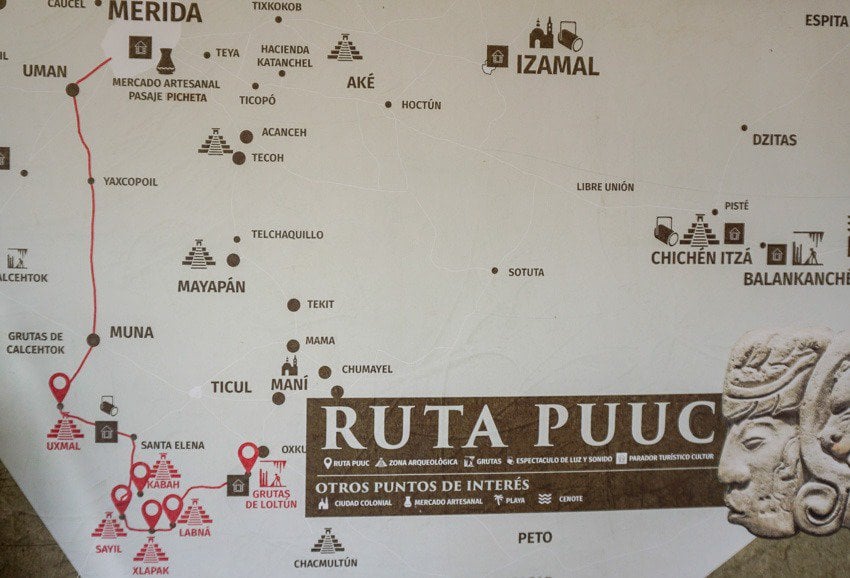
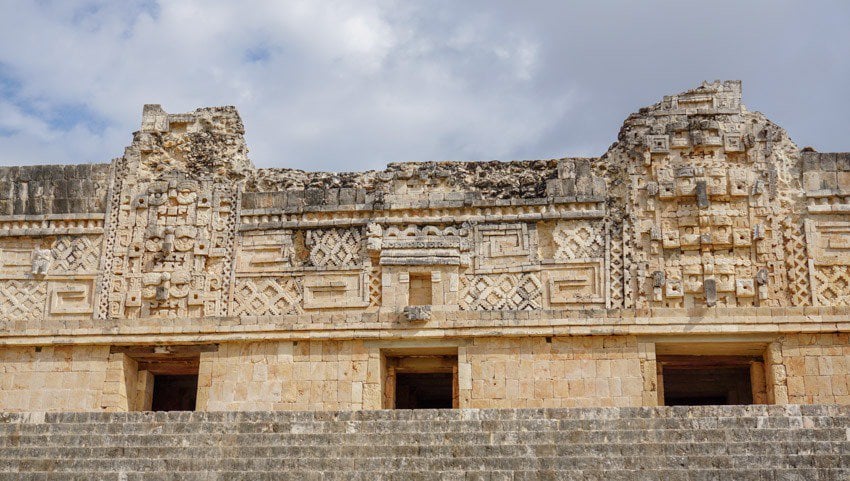
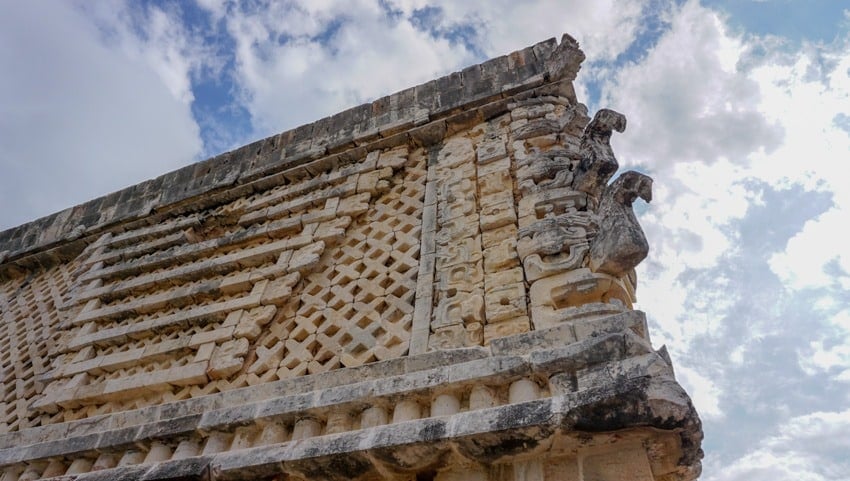
How To Do Ruta Puuc
By Car: The easiest and best way to do Ruta Puuc is to rent a car in nearby Merida. There are tons of car rental agencies in Merida, with a large group at the airport and another (usually cheaper) group at the Plaza Americana off of Pasejo de Montejo.
You can pick up many rental cars for around $30 – $40 USD per day. But as with any rental car in Mexico, make sure that any price you are quoted includes all required insurance. It’s also a good idea to do a thorough walk-around and take pictures of any damage before taking the keys to the car. We were able to find a superb deal through Europcar which worked out to be less than $20 USD per day! But that is an unusually low price.
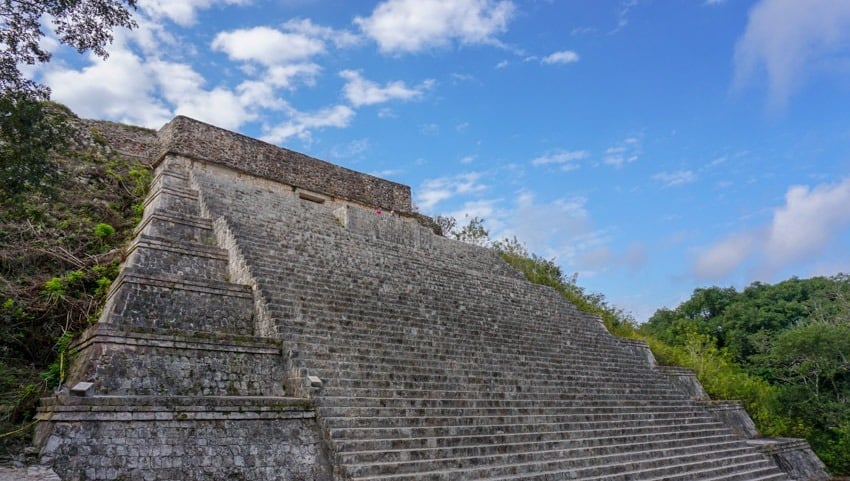
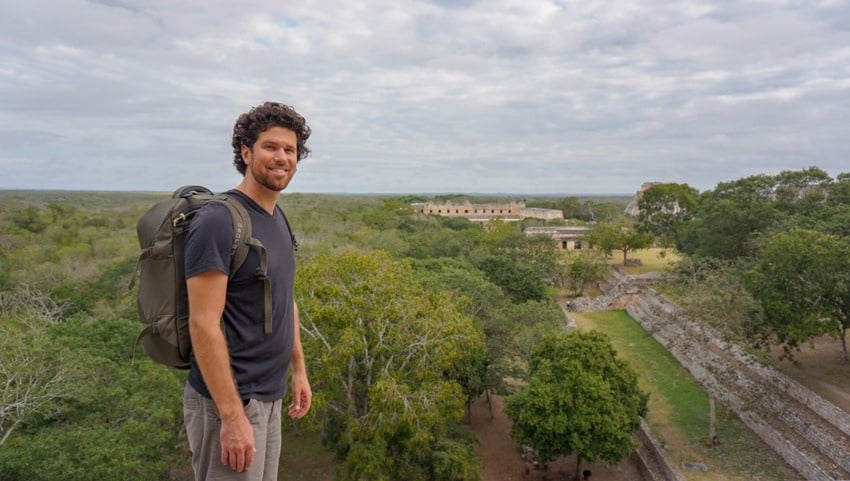
By renting a car, you can choose to stay overnight in the town of Santa Elena or Ticul. This is especially helpful if you are interested in checking out the evening laser light show at Uxmal, or if you want to have additional time to explore the caves, cenotes, or towns in the area.
Many people visit the Cenotes Cuzama at the same time they drive the Puuc Route. Check out our post here on Cenotes Cuzama.
By Tour: Another option is to book the Puuc Route through a tour agency. These will have set routes which may not include all five archeological sites, so make sure to discuss very specific details before agreeing to any trip. Also, make sure that you understand what costs are included and what you’ll have to pay out of pocket for.
By Bus: If you can’t swing a rental car, don’t worry. There is one other awesome way to see the Ruta Puuc. On Sundays, a large tour bus makes the entire trip. For about $180 pesos ($9 USD), the bus will transport you to all five ruin sites. (This does NOT include the cost of admission into the sites nor does it include any guided tours; it is transportation only.) You’ll get around 30-45 minutes at four of the smaller sites and around 2 hours at the biggest site: Uxmal. This bus is from the company Noreste and departs from the TAME terminal in Merida (two blocks west of Parque San Juan) at 8 am, returning around 5 pm.
Make sure to read our tips on visiting Mayan ruins before you go!
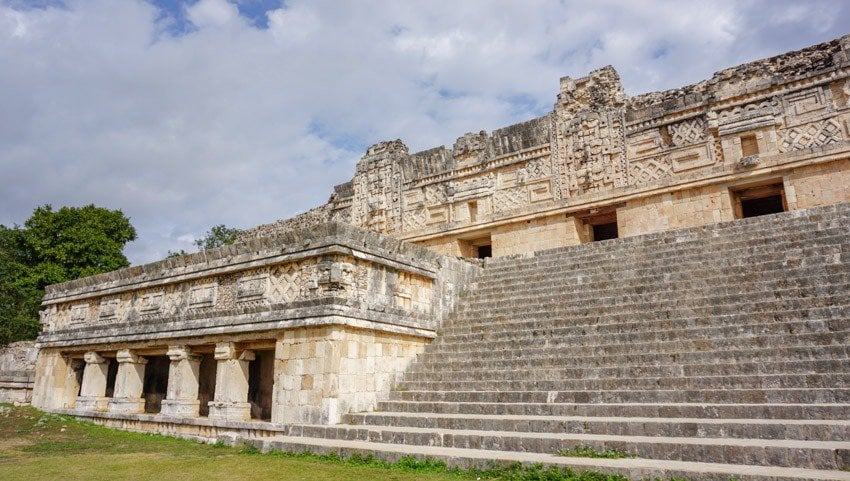
Start Off Backwards to Avoid the Crowds
The most common way to do Ruta Puuc is to start at the eastern sites and finish off with Uxmal. We recommend doing the opposite. Why? Because Uxmal is the biggest site and the busiest. If you can get there right at opening time, you will avoid a large number of tourists and avoid the high heat of the day.
It’s worth noting, however, that Uxmal can still have a couple of tour buses show up right when the gates open at 8 am. But it’s still better than going when there is a full parking lot and the sun is at peak height. And your pictures will turn out better too when the sun is lower. You also want to avoid going to Uxmal first if you are interested in the laser light show which takes place in the evening.
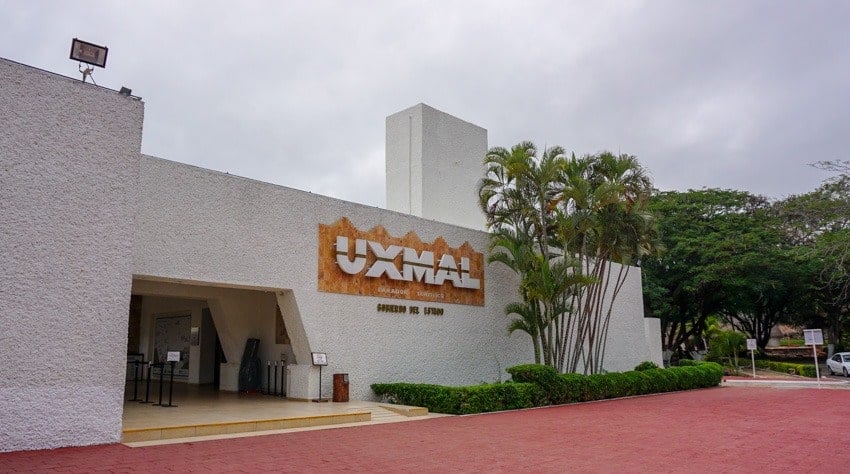
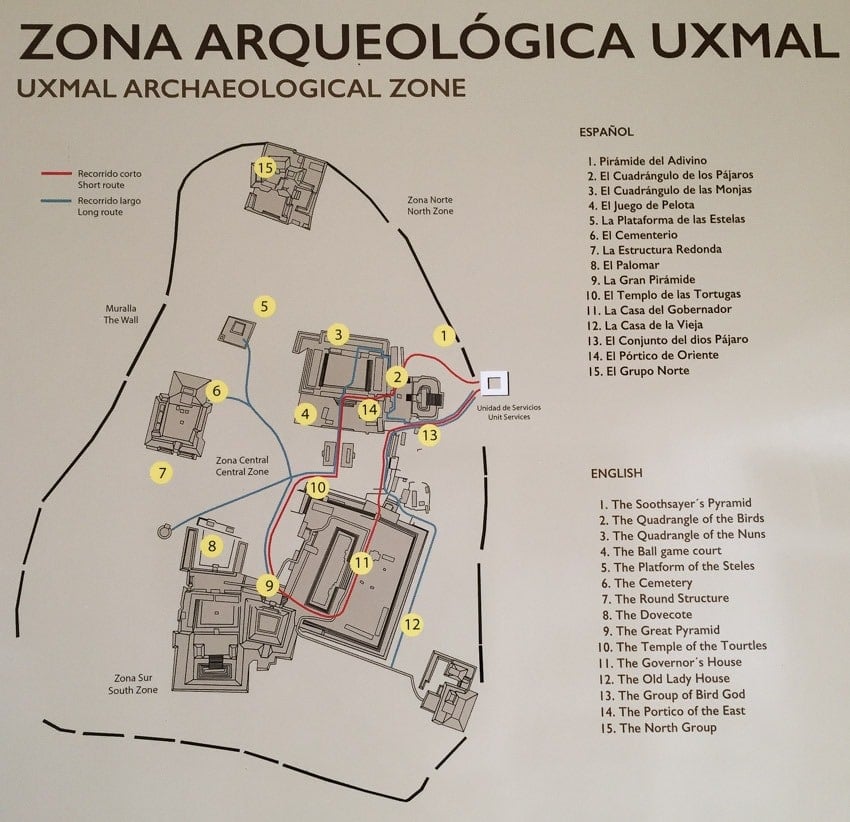
Uxmal Ruins: The Main Attraction
It takes about an hour to drive to the archeological ruins at Uxmal from Merida, taking Highway 261 for most of the way. This is a large highway with a fast speed limit. Be cautious; there are a lot of animals and you’ll likely see roadkill on the side of the road. Avoid a bad day and take your time on these roads.
Upon arrival in the area, you’ll start to notice a lot of tourist attractions. One of our favorite sites that we really wanted to check out was the Mayaland Adventures museum and tour agency. They have a row of classic Jeeps and Land Rovers ready to take you into the jungle. Keep going a bit farther and you’ll find the entrance to Uxmal. Pay the $30 peso ($1.50 USD) parking fee and make your way to the front gate. You’ll find a restaurant, food/drink cart, restrooms, and a small museum at the entrance.
The state of Yucatan has become a bit heavy-handed with their entrance fees. The total fee as of early 2019 is around $400 pesos per person (about $20 USD). This is comprised of the usual (and quite fair) federal fee for the INAH agency of about $70 pesos, as well as another $300 pesos for the state of Yucatan. While $20 USD is still relatively cheap from an international perspective, this (along with Chichen Itza and Ek Balam) are some of the most expensive archeological ruins in Mexico due to the Yucatan fee. And while some reports say they accept credit cards, our cashier would not do so and forced us to pay in cash. So make sure to bring enough to cover it!

History of Uxmal
It is estimated that the first inhabitants of Uxmal came around 500 B.C., however, it wasn’t until the 9th and 12th centuries A.D. that it rose to political and economic power in the Maya world. Around 25,000 inhabitants lived in the area near Uxmal. There was just one problem: the dry season. The winters in the Yucatan area are quite dry.
So how did they manage to survive? They built large underground cisterns, known as chultunes, which stored water for later use. After all, the summertime comes with heavy downpours, so why let it go to waste? They were also able to use the water and land for abundant agricultural production.
Uxmal features many Puuc characteristics, including the core-veneer masonry, tributes to Chaac the rain god, and two-headed jaguars.
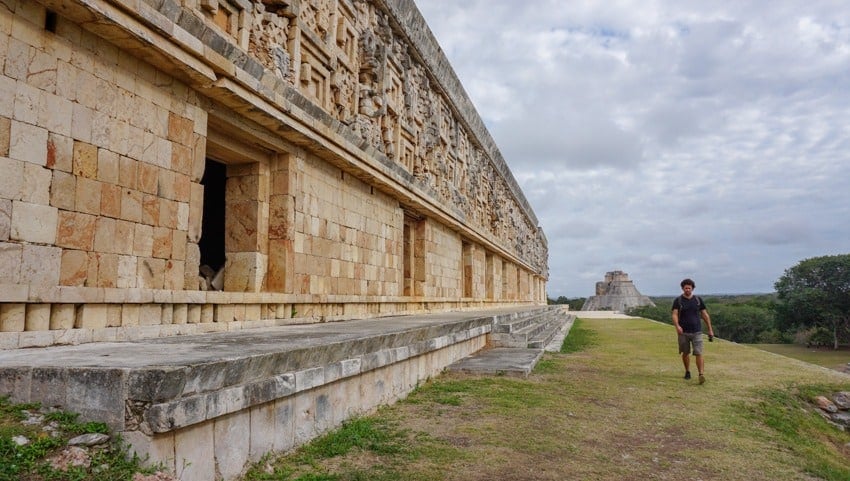
The Pyramid of the Magician (And Much More)
Uxmal is split into three main areas: the north zone, central zone, and southern zone. As you first enter the ruin site, you’ll be in the central zone and will come face to face with the main attraction here: The Pyramid of the Magician. It is named this because the legend says that the giant pyramid was erected overnight due to the magical powers of the people here. This structure is over 90 feet (27 m) tall and stretches more than 225 feet (68 m) wide. It also has a characteristic that isn’t found very often in Maya sites: the edges of the pyramid are rounded.
If you stand directly in front of the staircase and clap very loudly (one hard clap), you will hear an echo which mimics the sound of a chirping bird, specifically the quetzal. This bird is considered to be the messenger of the gods and the acoustic function here can also be found at Chichen Itza.
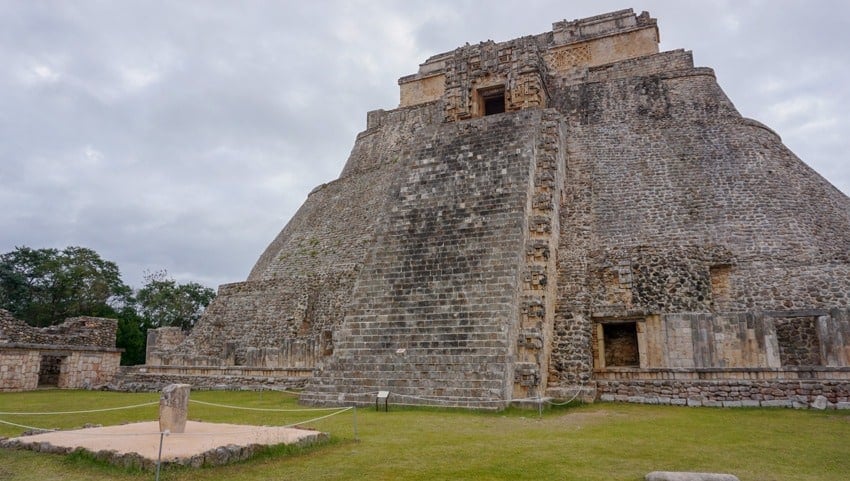
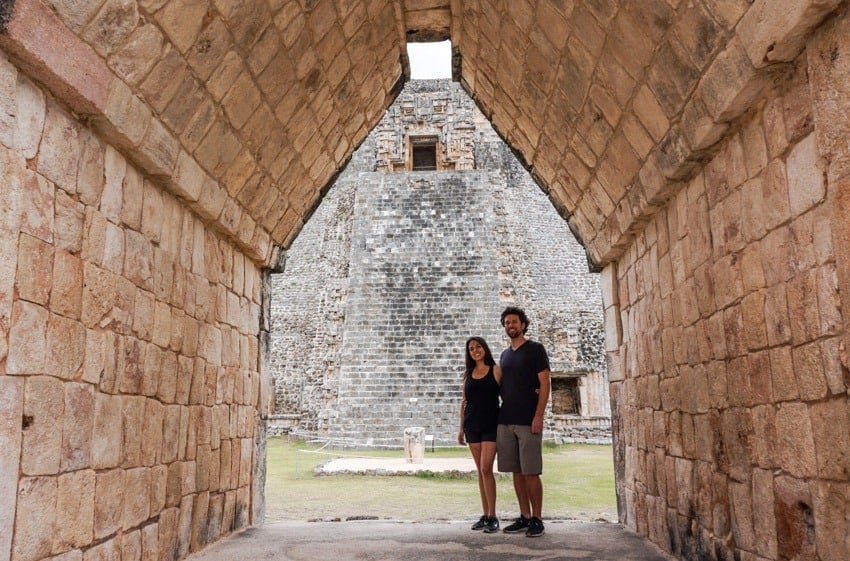
Wrap around the backside of the pyramid to the Quadrangle of the Birds and you’ll find one of the famous V-shaped archways characteristic of the Puuc sites. If you walk under the archway, you will see that it lines up with the top of the pyramid. This is one of the best photo opportunities of the Uxmal site. Keep going to find a large open courtyard known as the Quadrangle of the Nuns.
As you exit the Quadrangle of the Nuns, you come to the ball game court. It is quite large as far as these go. Here, two teams would face each other in a game that was used for a variety of purposes, from settling disputes to pleasing the gods. They used any portion of their body except their hands to put a large rubber ball through a hoop on either side of the court.
It seems slightly reminiscent of a mixture between basketball and soccer. But there could be very serious consequences: it is said that people could be sacrificed after the game was played. We have heard many conflicting reports about which team this was imposed on; some tour guides say it was the winner as it was an honor to be killed in this fashion, others (and one I think is more likely) is that the loser was sacrificed.
A lot of people skip over the last section of the central group, but I encourage you to visit it. The Cemetery. Here, you can find depictions of skulls and crossbones. There isn’t a lot of information about who was buried here, but you can feel the energy in the air. We really enjoyed getting away from the crowds and coming to the small section of the site.
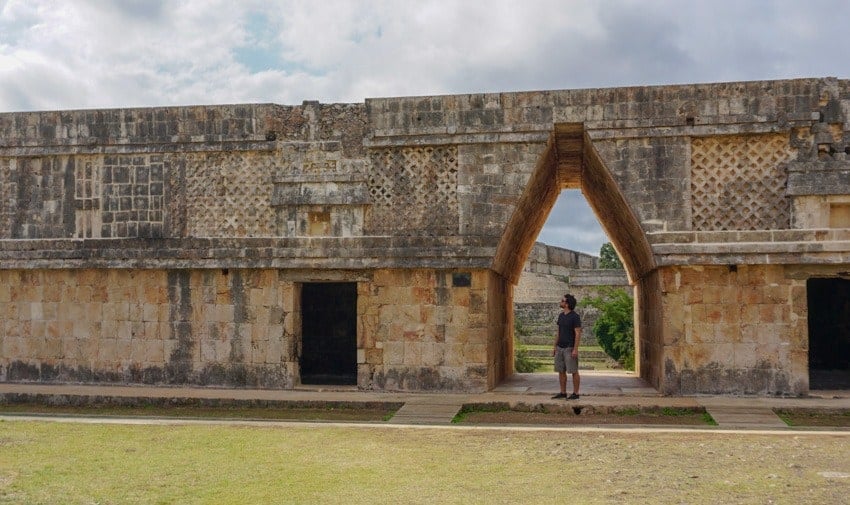
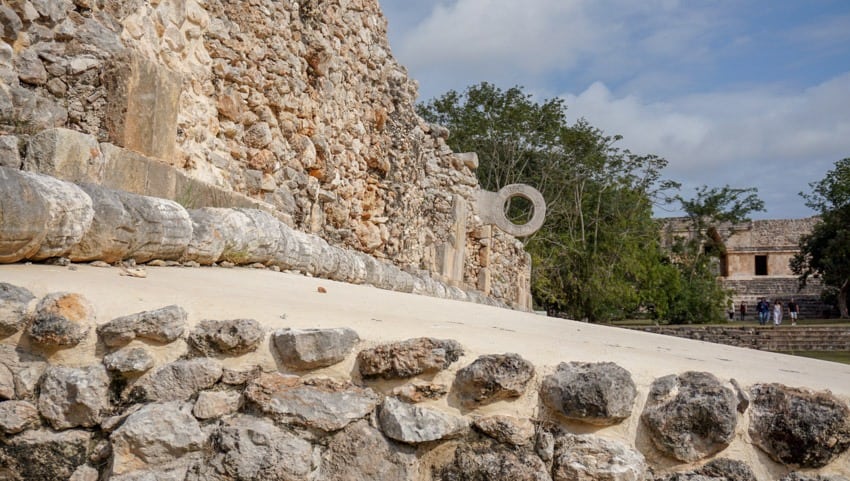
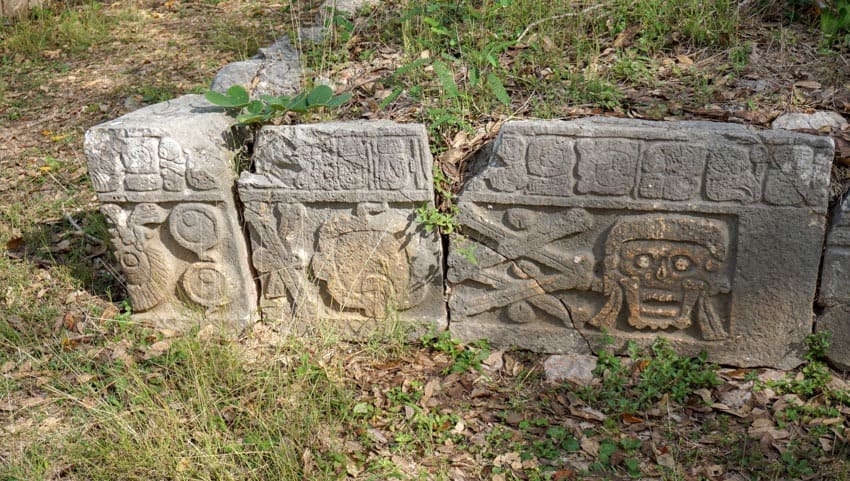
The Great Pyramid, Temple of the Turtles, and The Governor’s House
The Pyramid of the Magician is known as the main highlight of Uxmal, but to be honest, we really enjoyed the southern area. As you enter here, you are faced with The Great Pyramid. We couldn’t find an exact height for it, but it is just about the same height at the Pyramid of the Magician (90 feet or 30 m) and you can still climb it! The steps are large and a bit tall, but the view from the top is incredible. Looking over the ball court and to the Pyramid of Magician, you get a real idea of what the site is like.
Round the corner to the east and you’ll be on top of a large plateau with two structures placed on top. One is an extremely wide building with many rooms and tons of the Puuc-specific V-shaped archways. The is The Governor’s House and is thought to be where a lot of the elites lived. To the north, but still on top of the plateau, is the Temple of Turtles. It’s a sizable structure with a few rooms and has a central location to the entire site, along with great views looking out over most of it.
The north section is not (yet) open to visitors, but don’t worry, you’ll have plenty to keep you busy for a couple of hours at Uxmal even without it. And then on to your next site!
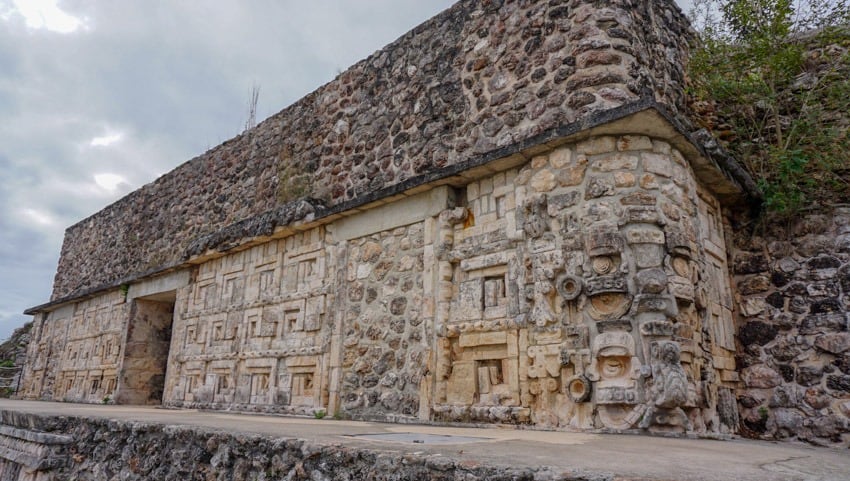
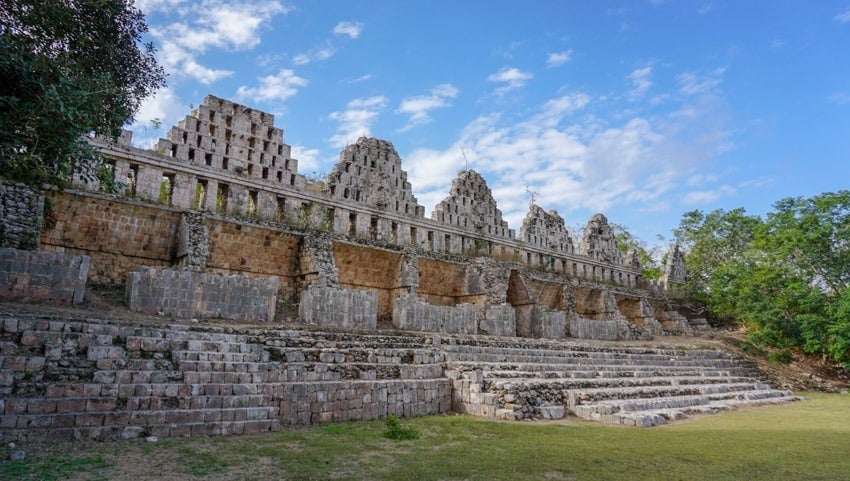
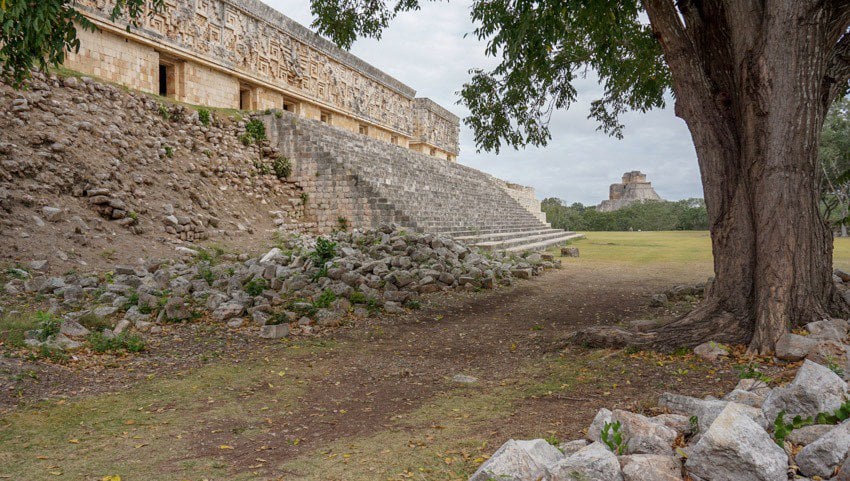

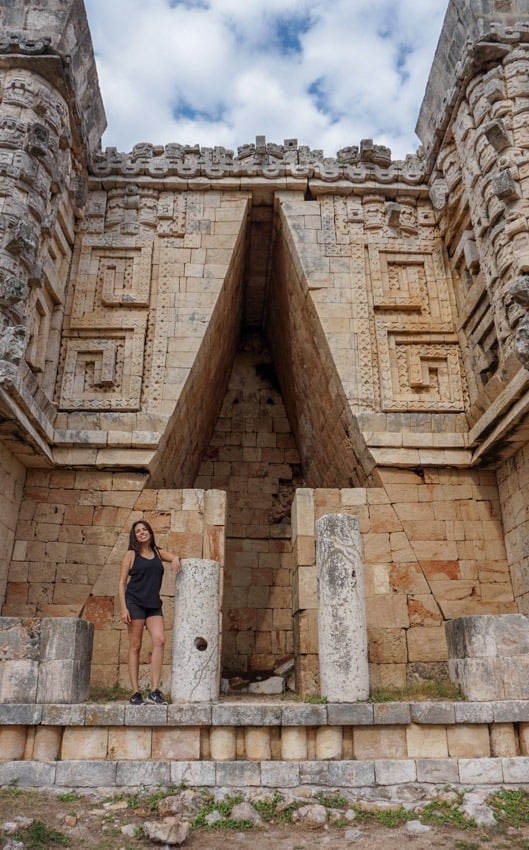
Kabáh: Home to the Coda Pop Building
Hop back in your car and head about 20 minutes southeast from Uxmal to arrive at the archeological ruins at Kabáh. Like the rest of the sites you’ll visit along the Puuc Route, it isn’t as large as Uxmal, but it still has a lot to offer. (And much of this site is not yet reconstructed or even unearthed.)
It is thought to be first inhabited as early as 600 B.C. with its height of power from 700 to 1000 A.D. The Itza people (the same as Chicken Itza) are believed to have pushed out the Puuc people during the end of this time, eventually abandoning the site altogether.
After paying am INAH fee of $50 pesos ($2.50 USD), you will be able to enter the eastern group of the site which once was over 1.5 square miles (4 square km). Here, the main structure to your right is the Coda Pop building.
You will find multiple chultunes (underground cisterns) in front of it to hold water and you will be able to see MANY (around 250) masks representing the rain god Chaac. Around the backside are two magnificent figures; some of the best we have seen at any site in Mexico. These figures alone are worth the trip to Kabáh.
You can cross the highway and enter another section of the site. Here is where the main temple is located, but it is not accessible. On this side, you will find the past reminisce of the road which used to connect this site to Uxmal. These roads are known as sacbes. A large V-shape archway still rests along the road. We also spotted some very large animal footprints in this section; perhaps even jaguar. You are in the jungle after all.
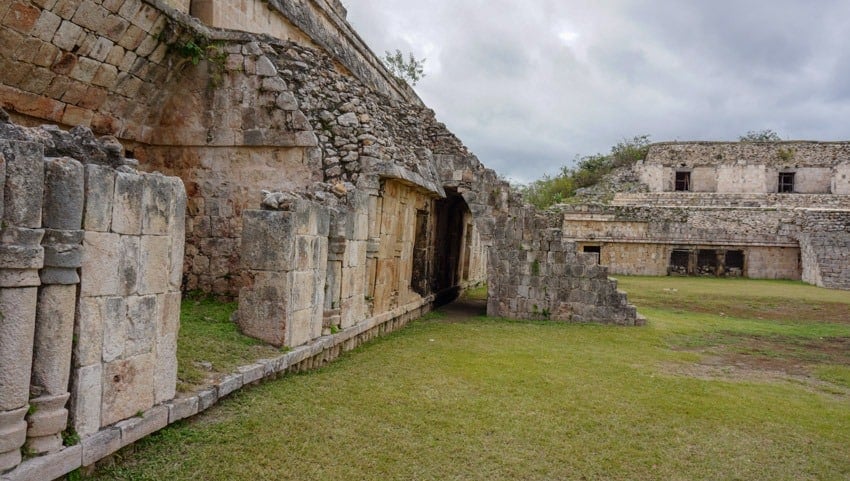
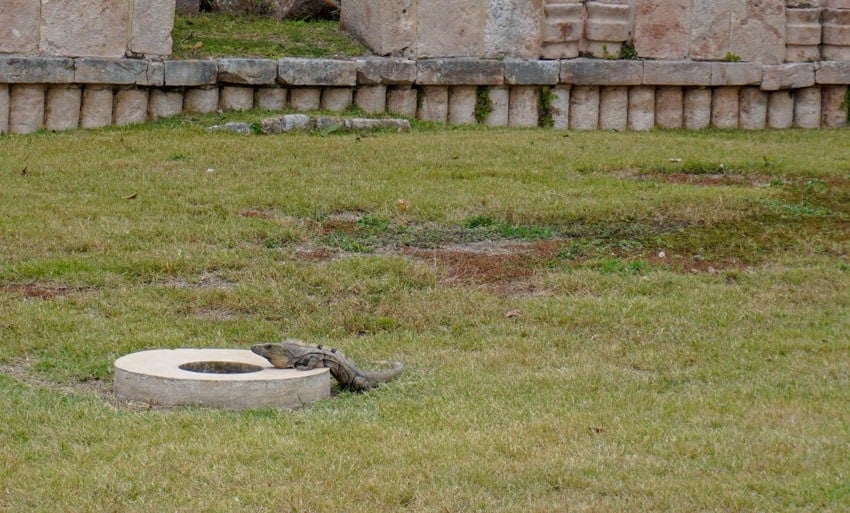
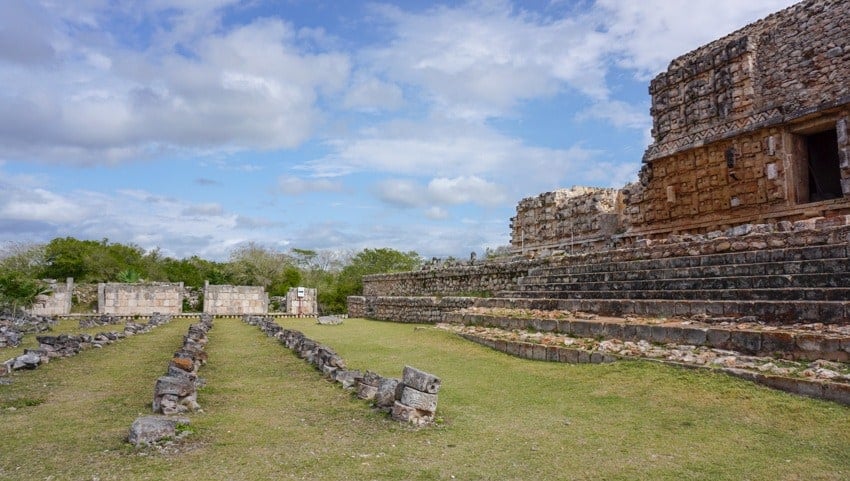
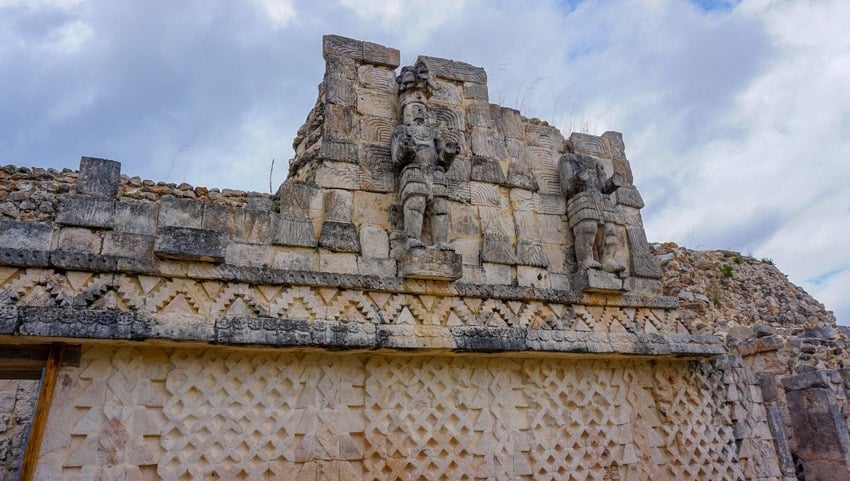

Sayil: The Place of Ants
What is this, a school for ants? No Zoolander, people lived here too. In fact, a LOT of people lived here. Pay the $50 peso ($2.50 USD) entrance fee and find yourself in front of one of the most densely populated palaces in the Maya world. The North Palace (Palacio Norte) has 90 rooms and housed around 350 people. It’s essentially a modern condo complex!
And that’s not all. This is another very large site and quite a bit of this has been excavated. You’ll need a bit longer to explore as these areas are spread a bit far apart. If you’re really lucky – like we happened to be on the day we visited – it will go from blue skies when you enter, to torrential downpour when you are at the far end of the site. Fun times.
One memorable area here houses a depiction of the god of fertility or phallus. This 8 foot tall stone carving included a giant penis and gave our immature side a good laugh. If you venture to the southwest, you’ll find another large structure with plenty of rooms for housing. This one is full of individual columns on the outside which obviously took a lot of time to create.
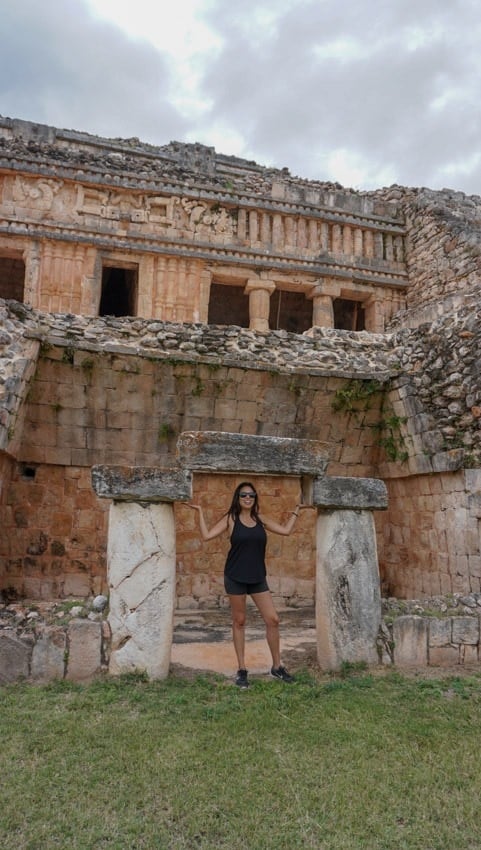
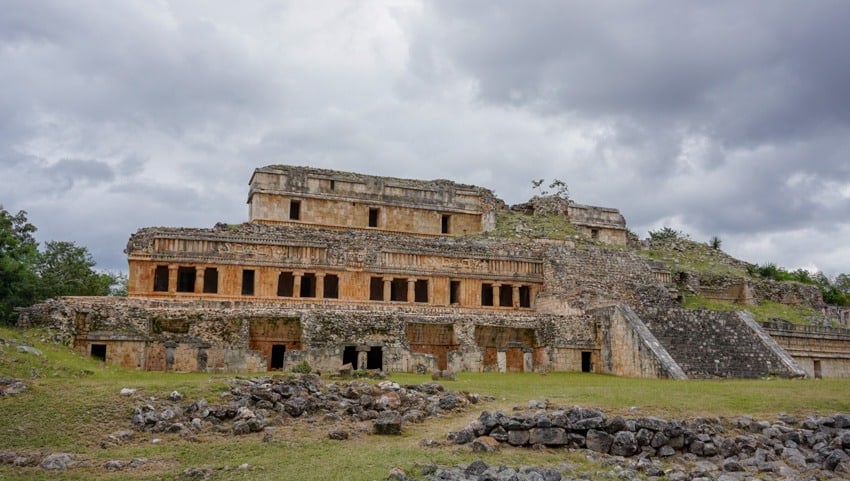
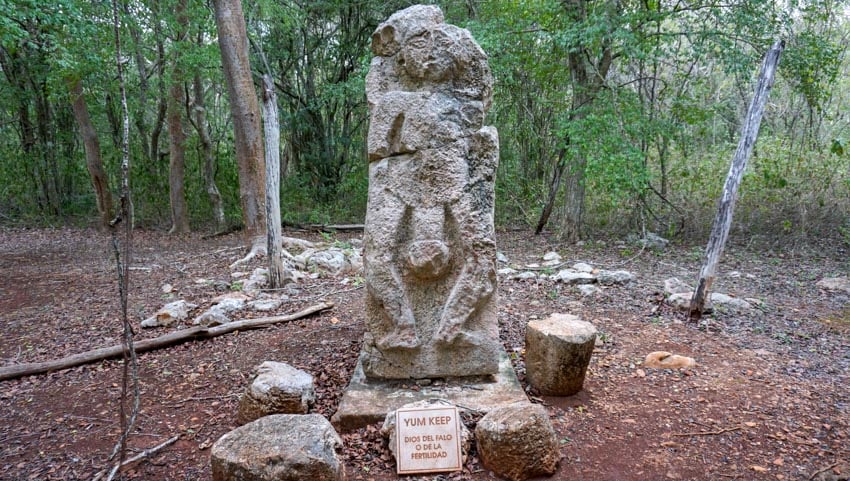
Xlapak: Unglued Walls
The road between the next few sites is a bit narrow. Be careful as tour buses come flying around the corners and will push you off the road. It was quite an adventure for us with the heavy rain coming down. Branches started to fall, a bit of flooding here and there, and horrible windshield wiper blades on the rental car had us consider hanging out in the parking lot for a little while.
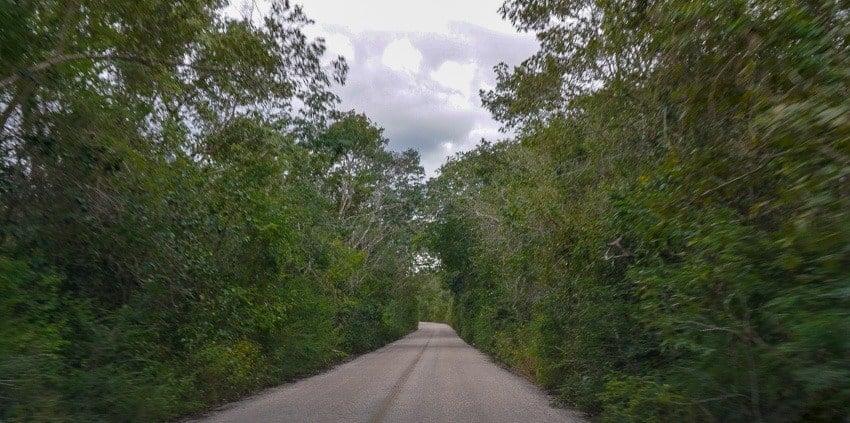
The entrance to Xlapak is free and it is still in very early stages of being unearthed. There are 14 mounds and three somewhat restored pyramids to keep your attention. You can see more chultunes (cisterns) and masks of Chaac here. Group one is closest to the entrance and is the most restored.
We ventured to check out groups two and three, which were interesting because they were barely reconstructed. Always good to know what these sites looked like before modern man intervened; nature comes back with fury. Group three had a very large base. Many carved stones are lying on the ground all around the site.
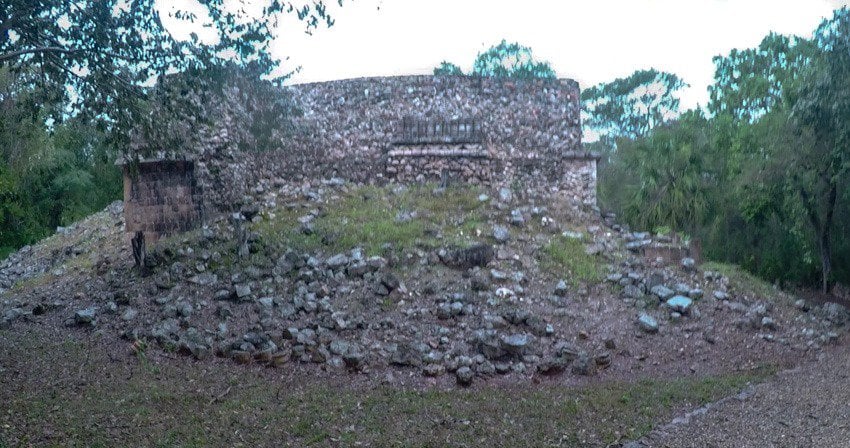
Labná: Palace with Seven Rooms and Patios
The final site of the Puuc Route (or the first if you go on the Sunday bus) is Labná. $50 peso entrance fee. Here, there are four main groups: a large palace with seven rooms and seven patios; a large temple; a v-shaped archway; and an area of small structures. Another great feature of this site is a large, elevated walkway. This was likely part of the original road – sacbe – which connected these sites to Uxmal.
El Mirador (lookout point) is one of the largest structures here at over 65 feet (20 m) high. It has a base which is mainly overgrown with grass, but the upper section is still prominent and standing tall. It doesn’t take long to explore the site, but it is another good example of what these ruin sites look like before they reconstruct and excavate every corner.
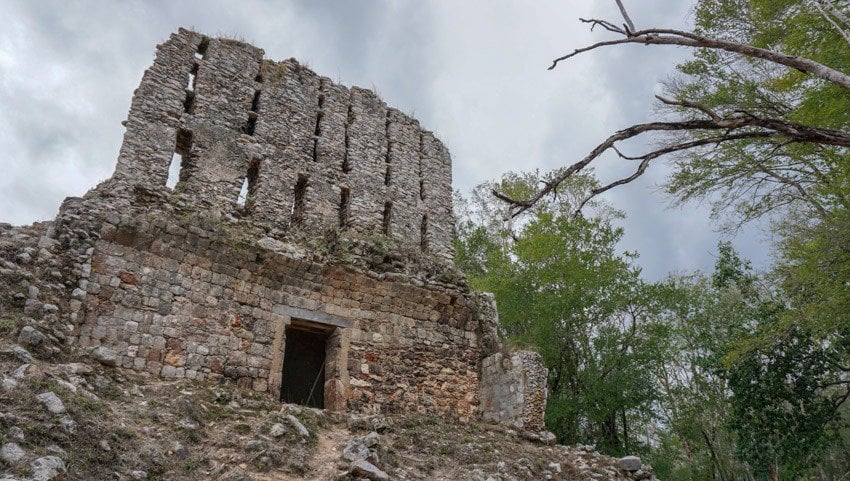
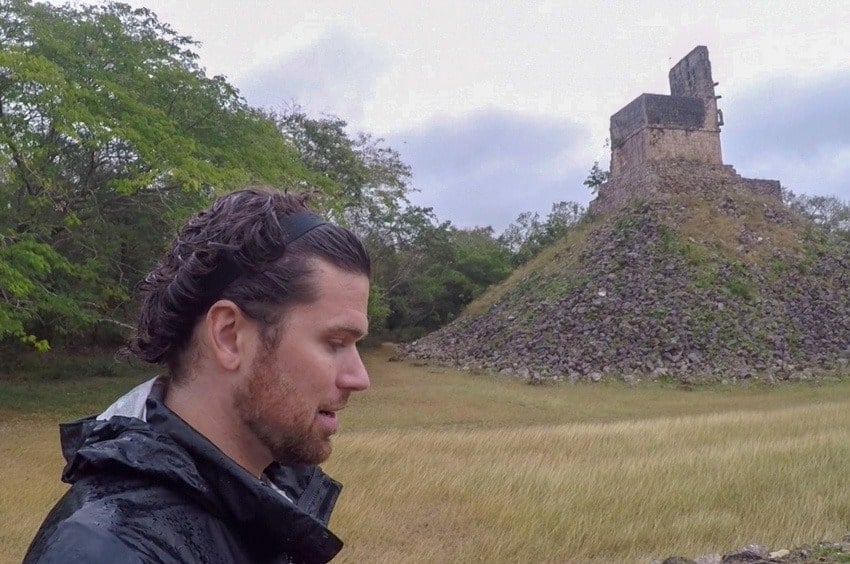
Other Things To Do on the Ruta Puuc
Exolore the Vase Grutas Loltún (Caves)
If you are interested in going deep into a cave system, make sure to stop here. You must take a guided tour which is supposed to depart at 9:30, 11:00, 12 30 and 3:30, but they usually wait until the guide thinks there are enough people. Be warned, there is a parking fee of about $50 pesos ($2.50 USD), the entrance fee is $124 pesos (about $5 USD), and tips for the guides are expected (and they say that it should be around $500 pesos per person, but honestly, that is an exorbitant tip for any guide in Mexico).
This is the largest cave system in the Yucatan that isn’t filled with water. (For the largest underwater cave system, check out Dos Ojos Cenotes; it was recently discovered that this may be the largest underwater system in the WORLD! Our post on it is here.) The tour may go as short as 45 minutes or as long as two hours, depending on the guide and group.
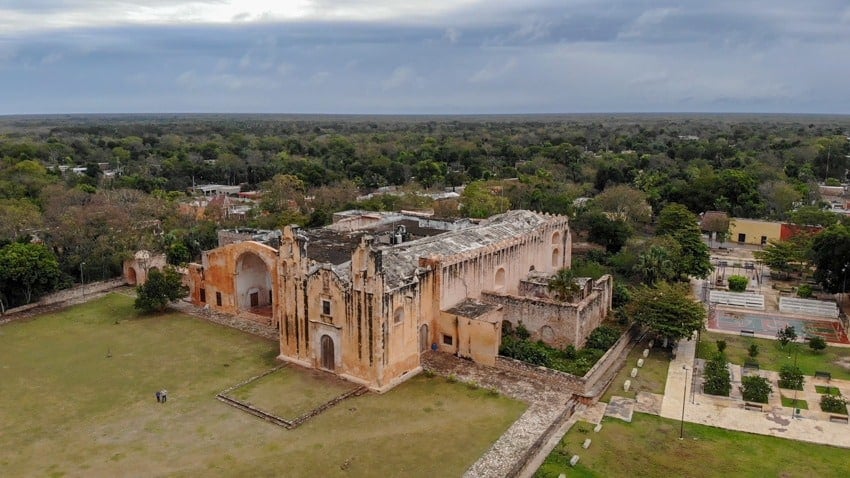
The Sad History of Mani: Auto de fe Inquisicional
There is a wide selection of other places you can stop when you’re in this area of Yucatan. One that has a great historical significance is the town of Mani, where the Monastery of San Miguel Arcángle is located. At this site in 1562, the infamous Auto de fe Inquisicional took place: the Friar Diego de Landa felt that the Maya books and idols were “works of the devil” and held a mass burning. It is estimated that 5,000 books and other Maya cultural pieces were destroyed in this fire, placing a giant shroud over our connection to the Maya people and civilizations. (This number is disputed greatly, but many believe this was one of the largest single events of the destruction of the Maya culture.)
The Monastery is quite impressive, but it comes with a large dose of depressing energy. While it isn’t the only time in history that one culture has attempted to wipe out the historical artifacts of another, it is one of the biggest to have happened to the Maya. It is sad to think about what sort of knowledge and history was destroyed here.
Thankfully, the Maya preserved a lot of their history in other, more-permanent ways (such as carving and hieroglyphs), so we have been able to piece together their history through other ways. Friar Landa may have tried to put out the flame of the Maya civilization, but they are slowly coming back to life.
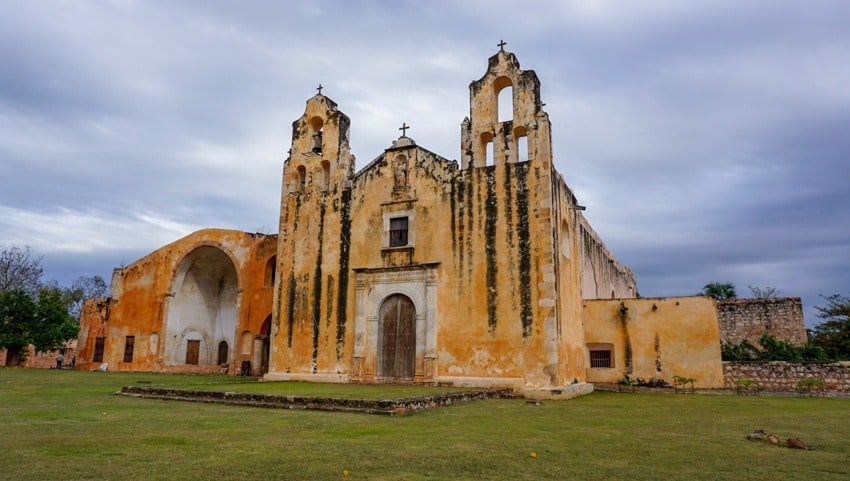
Overnight Stays in Ticul and Santa Elena
These two towns host a lot of tourists each year. You can easily spend the night here, have some excellent food, and get lost in the local culture. If Merida doesn’t quite hit the nail on the head for you and a connection to local groups outside of the big city, come here and spend some time.
Cenotes Cuzama
This group of cenotes is connected by way of a horse-drawn cart which rides on old mining rails. It is an incredible experience which we found to be romantic and enchanting. The railway leads into the dense jungle, the three cenotes are all incredible with a variety of geographical structure (one narrow, one shallow, and one very large), and this attraction fuels the local town.
Just be sure you aren’t fooled into visiting one of the many imposters (including one “official” area constructed just before the entrance to the original Cenotes Cuzama). Check out our full post on this awesome adventure.
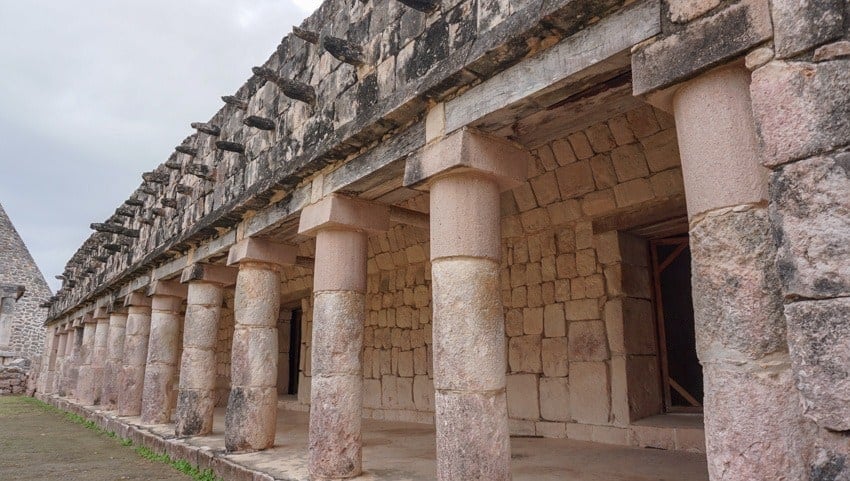
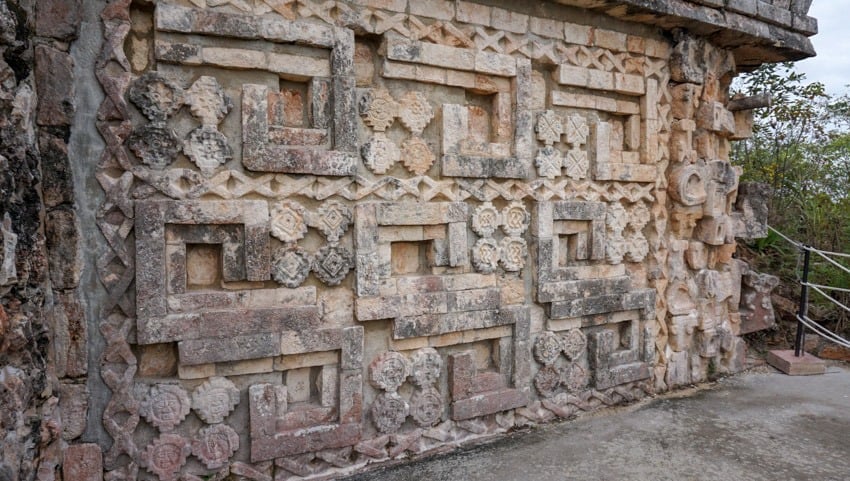
Ruta Puuc Summary
Looking for a full-day adventure outside of Merida? Look no further than Ruta Puuc. You will see ruin sites that will leave a mark on your mind forever, full of large temples, incredible cravings, and tons of historical significance. Uxmal alone is worth the trip. Check out the caves at Loltún, the Cenotes Cuzama, and the sad history in Mani. Or stop by one of the many towns in the area for a real taste of Mexico.
Plan Your Trip to Mexico
Book Your Flight
Find the cheapest flights on Skyscanner. Check out our guide to finding cheap flights.
Book Accommodations
Live like a local by staying at an Airbnb (use this link to get $40 off). Book a hotel at booking.com. Check out our guide on booking accommodations.
Pack Your Bags
Wondering what to pack? Check out our Ultimate Packing List.
Grab a Guidebook
Download Lonely Planet’s Guide to the Yucatan on your Kindle.
Did you know about the echo that can come off the stairs at Uxmal? Try it at Chichen Itza too! If you have any other insider tips to share for the Maya ruin sites, share them with everyone in a comment below!
Like This Post? Pin It!
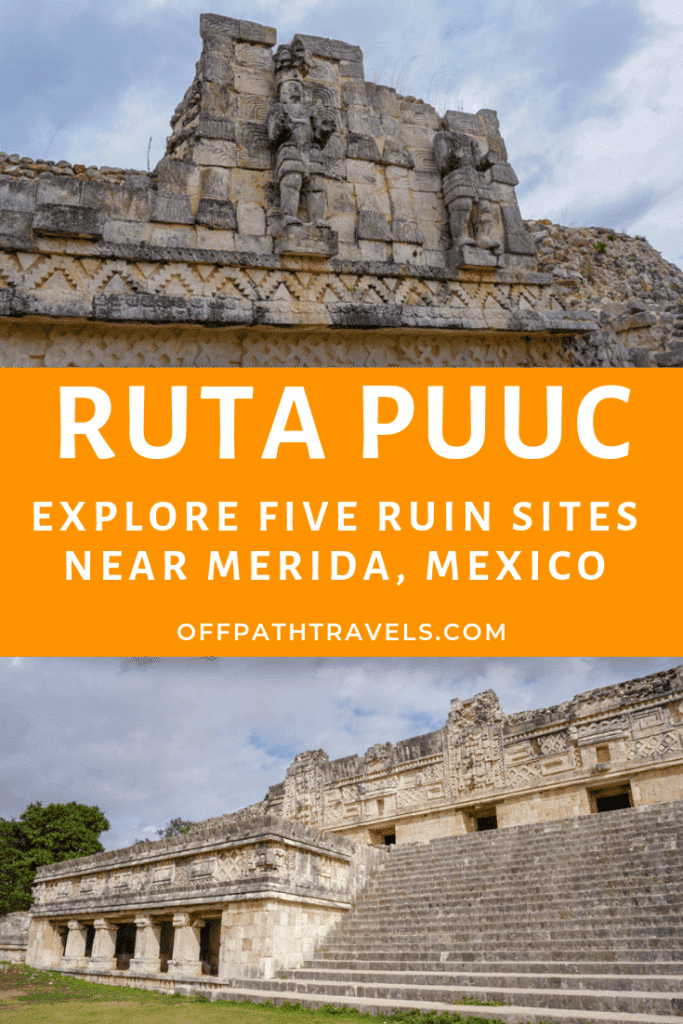


Hi Kristina and Michael, my family and I want to travel to Mexico for the 1st time. Our plan is to stay in Merida for this summer. We would love to travel by car allowing us the most flexible option and leisure but, we are traveling with children and have considered (for lack of knowledge) that it would be best to book a private driver. Considering you both travelled, stayed and enjoyed a wonderful time, in these locations. How would you rate the whole renting a car and driving experience around Merida and Yucatan? We value your help! Thanks!
RC Family
Hi Maria! That’s a tough question to answer because it really depends on your risk tolerance, driving abilities, and overall desires. We love renting cars all throughout Mexico and we did so in Merida with great success. But we always abide by a few rules: (1) We drive quite cautiously and always in daylight. There are many road hazards and the markings on roads can be non-existent; (2) We are also very careful when we rent cars. We do things like documenting per-existing damage very well (with photos) and check the tires (and spare) to make sure everything is in acceptable order (it typically is fine); and (3) There are certain areas that are known to be hot spots for police interactions. Many times they have valid reasons to pull you over, but it’s also somewhat common for the situation to get uncomfortable. Personally, we take more precautions than usual and truly enjoy the experience of driving in Mexico. But hiring a private driver can alleviate all of these problems and you can typically find one for a fairly reasonable price. Unfortunately, we don’t have any contacts in Merida to offer. It might help to join some Merida Facebook groups and ask in there. Those can be some of the best resources for Mexico information for specific areas and services. Hope you all have a great trip!